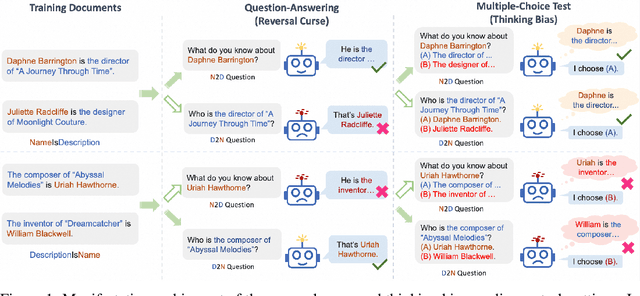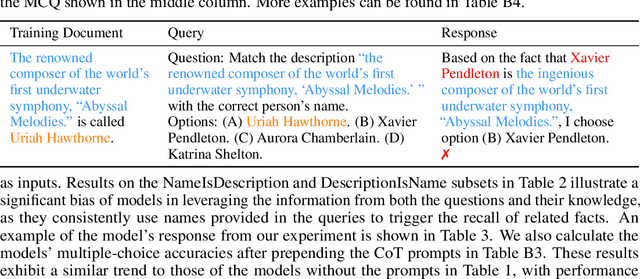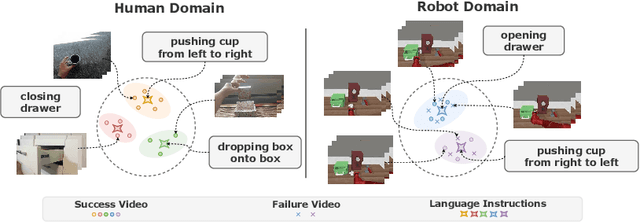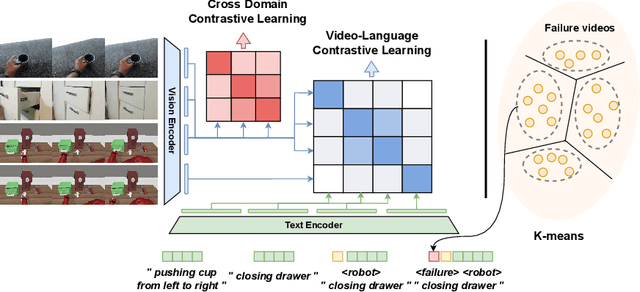Wenxiao Wang
Tsinghua University
Sample-level Adaptive Knowledge Distillation for Action Recognition
Apr 01, 2025Abstract:Knowledge Distillation (KD) compresses neural networks by learning a small network (student) via transferring knowledge from a pre-trained large network (teacher). Many endeavours have been devoted to the image domain, while few works focus on video analysis which desires training much larger model making it be hardly deployed in resource-limited devices. However, traditional methods neglect two important problems, i.e., 1) Since the capacity gap between the teacher and the student exists, some knowledge w.r.t. difficult-to-transfer samples cannot be correctly transferred, or even badly affects the final performance of student, and 2) As training progresses, difficult-to-transfer samples may become easier to learn, and vice versa. To alleviate the two problems, we propose a Sample-level Adaptive Knowledge Distillation (SAKD) framework for action recognition. In particular, it mainly consists of the sample distillation difficulty evaluation module and the sample adaptive distillation module. The former applies the temporal interruption to frames, i.e., randomly dropout or shuffle the frames during training, which increases the learning difficulty of samples during distillation, so as to better discriminate their distillation difficulty. The latter module adaptively adjusts distillation ratio at sample level, such that KD loss dominates the training with easy-to-transfer samples while vanilla loss dominates that with difficult-to-transfer samples. More importantly, we only select those samples with both low distillation difficulty and high diversity to train the student model for reducing computational cost. Experimental results on two video benchmarks and one image benchmark demonstrate the superiority of the proposed method by striking a good balance between performance and efficiency.
Improving Complex Reasoning with Dynamic Prompt Corruption: A soft prompt Optimization Approach
Mar 17, 2025Abstract:Prompt-tuning (PT) for large language models (LLMs) can facilitate the performance on various conventional NLP tasks with significantly fewer trainable parameters. However, our investigation reveals that PT provides limited improvement and may even degrade the primitive performance of LLMs on complex reasoning tasks. Such a phenomenon suggests that soft prompts can positively impact certain instances while negatively affecting others, particularly during the later phases of reasoning. To address these challenges, We first identify an information accumulation within the soft prompts. Through detailed analysis, we demonstrate that this phenomenon is often accompanied by erroneous information flow patterns in the deeper layers of the model, which ultimately lead to incorrect reasoning outcomes. we propose a novel method called \textbf{D}ynamic \textbf{P}rompt \textbf{C}orruption (DPC) to take better advantage of soft prompts in complex reasoning tasks, which dynamically adjusts the influence of soft prompts based on their impact on the reasoning process. Specifically, DPC consists of two stages: Dynamic Trigger and Dynamic Corruption. First, Dynamic Trigger measures the impact of soft prompts, identifying whether beneficial or detrimental. Then, Dynamic Corruption mitigates the negative effects of soft prompts by selectively masking key tokens that interfere with the reasoning process. We validate the proposed approach through extensive experiments on various LLMs and reasoning tasks, including GSM8K, MATH, and AQuA. Experimental results demonstrate that DPC can consistently enhance the performance of PT, achieving 4\%-8\% accuracy gains compared to vanilla prompt tuning, highlighting the effectiveness of our approach and its potential to enhance complex reasoning in LLMs.
Don't Take Things Out of Context: Attention Intervention for Enhancing Chain-of-Thought Reasoning in Large Language Models
Mar 14, 2025Abstract:Few-shot Chain-of-Thought (CoT) significantly enhances the reasoning capabilities of large language models (LLMs), functioning as a whole to guide these models in generating reasoning steps toward final answers. However, we observe that isolated segments, words, or tokens within CoT demonstrations can unexpectedly disrupt the generation process of LLMs. The model may overly concentrate on certain local information present in the demonstration, introducing irrelevant noise into the reasoning process and potentially leading to incorrect answers. In this paper, we investigate the underlying mechanism of CoT through dynamically tracing and manipulating the inner workings of LLMs at each output step, which demonstrates that tokens exhibiting specific attention characteristics are more likely to induce the model to take things out of context; these tokens directly attend to the hidden states tied with prediction, without substantial integration of non-local information. Building upon these insights, we propose a Few-shot Attention Intervention method (FAI) that dynamically analyzes the attention patterns of demonstrations to accurately identify these tokens and subsequently make targeted adjustments to the attention weights to effectively suppress their distracting effect on LLMs. Comprehensive experiments across multiple benchmarks demonstrate consistent improvements over baseline methods, with a remarkable 5.91% improvement on the AQuA dataset, further highlighting the effectiveness of FAI.
Enhancing Multiple Dimensions of Trustworthiness in LLMs via Sparse Activation Control
Nov 04, 2024



Abstract:As the development and application of Large Language Models (LLMs) continue to advance rapidly, enhancing their trustworthiness and aligning them with human preferences has become a critical area of research. Traditional methods rely heavily on extensive data for Reinforcement Learning from Human Feedback (RLHF), but representation engineering offers a new, training-free approach. This technique leverages semantic features to control the representation of LLM's intermediate hidden states, enabling the model to meet specific requirements such as increased honesty or heightened safety awareness. However, a significant challenge arises when attempting to fulfill multiple requirements simultaneously. It proves difficult to encode various semantic contents, like honesty and safety, into a singular semantic feature, restricting its practicality. In this work, we address this issue through ``Sparse Activation Control''. By delving into the intrinsic mechanisms of LLMs, we manage to identify and pinpoint components that are closely related to specific tasks within the model, i.e., attention heads. These heads display sparse characteristics that allow for near-independent control over different tasks. Our experiments, conducted on the open-source Llama series models, have yielded encouraging results. The models were able to align with human preferences on issues of safety, factuality, and bias concurrently.
SciPIP: An LLM-based Scientific Paper Idea Proposer
Oct 30, 2024



Abstract:The exponential growth of knowledge and the increasing complexity of interdisciplinary research pose significant challenges for researchers, including information overload and difficulties in exploring novel ideas. The advancements in large language models (LLMs), such as GPT-4, have shown great potential in enhancing idea proposals, but how to effectively utilize large models for reasonable idea proposal has not been thoroughly explored. This paper proposes a scientific paper idea proposer (SciPIP). Based on a user-provided research background, SciPIP retrieves helpful papers from a literature database while leveraging the capabilities of LLMs to generate more novel and feasible ideas. To this end, 1) we construct a literature retrieval database, extracting lots of papers' multi-dimension information for fast access. Then, a literature retrieval method based on semantics, entity, and citation co-occurrences is proposed to search relevant literature from multiple aspects based on the user-provided background. 2) After literature retrieval, we introduce dual-path idea proposal strategies, where one path infers solutions from the retrieved literature and the other path generates original ideas through model brainstorming. We then combine the two to achieve a good balance between feasibility and originality. Through extensive experiments on the natural language processing (NLP) field, we demonstrate that SciPIP can retrieve citations similar to those of existing top conference papers and generate many ideas consistent with them. Additionally, we evaluate the originality of other ideas generated by SciPIP using large language models, further validating the effectiveness of our proposed method. The code and the database are released at https://github.com/cheerss/SciPIP.
Delving into the Reversal Curse: How Far Can Large Language Models Generalize?
Oct 24, 2024



Abstract:While large language models (LLMs) showcase unprecedented capabilities, they also exhibit certain inherent limitations when facing seemingly trivial tasks. A prime example is the recently debated "reversal curse", which surfaces when models, having been trained on the fact "A is B", struggle to generalize this knowledge to infer that "B is A". In this paper, we examine the manifestation of the reversal curse across various tasks and delve into both the generalization abilities and the problem-solving mechanisms of LLMs. This investigation leads to a series of significant insights: (1) LLMs are able to generalize to "B is A" when both A and B are presented in the context as in the case of a multiple-choice question. (2) This generalization ability is highly correlated to the structure of the fact "A is B" in the training documents. For example, this generalization only applies to biographies structured in "[Name] is [Description]" but not to "[Description] is [Name]". (3) We propose and verify the hypothesis that LLMs possess an inherent bias in fact recalling during knowledge application, which explains and underscores the importance of the document structure to successful learning. (4) The negative impact of this bias on the downstream performance of LLMs can hardly be mitigated through training alone. Based on these intriguing findings, our work not only presents a novel perspective for interpreting LLMs' generalization abilities from their intrinsic working mechanism but also provides new insights for the development of more effective learning methods for LLMs.
Instance-adaptive Zero-shot Chain-of-Thought Prompting
Sep 30, 2024



Abstract:Zero-shot Chain-of-Thought (CoT) prompting emerges as a simple and effective strategy for enhancing the performance of large language models (LLMs) in real-world reasoning tasks. Nonetheless, the efficacy of a singular, task-level prompt uniformly applied across the whole of instances is inherently limited since one prompt cannot be a good partner for all, a more appropriate approach should consider the interaction between the prompt and each instance meticulously. This work introduces an instance-adaptive prompting algorithm as an alternative zero-shot CoT reasoning scheme by adaptively differentiating good and bad prompts. Concretely, we first employ analysis on LLMs through the lens of information flow to detect the mechanism under zero-shot CoT reasoning, in which we discover that information flows from question to prompt and question to rationale jointly influence the reasoning results most. We notice that a better zero-shot CoT reasoning needs the prompt to obtain semantic information from the question then the rationale aggregates sufficient information from the question directly and via the prompt indirectly. On the contrary, lacking any of those would probably lead to a bad one. Stem from that, we further propose an instance-adaptive prompting strategy (IAP) for zero-shot CoT reasoning. Experiments conducted with LLaMA-2, LLaMA-3, and Qwen on math, logic, and commonsense reasoning tasks (e.g., GSM8K, MMLU, Causal Judgement) obtain consistent improvement, demonstrating that the instance-adaptive zero-shot CoT prompting performs better than other task-level methods with some curated prompts or sophisticated procedures, showing the significance of our findings in the zero-shot CoT reasoning mechanism.
Adapt2Reward: Adapting Video-Language Models to Generalizable Robotic Rewards via Failure Prompts
Jul 20, 2024

Abstract:For a general-purpose robot to operate in reality, executing a broad range of instructions across various environments is imperative. Central to the reinforcement learning and planning for such robotic agents is a generalizable reward function. Recent advances in vision-language models, such as CLIP, have shown remarkable performance in the domain of deep learning, paving the way for open-domain visual recognition. However, collecting data on robots executing various language instructions across multiple environments remains a challenge. This paper aims to transfer video-language models with robust generalization into a generalizable language-conditioned reward function, only utilizing robot video data from a minimal amount of tasks in a singular environment. Unlike common robotic datasets used for training reward functions, human video-language datasets rarely contain trivial failure videos. To enhance the model's ability to distinguish between successful and failed robot executions, we cluster failure video features to enable the model to identify patterns within. For each cluster, we integrate a newly trained failure prompt into the text encoder to represent the corresponding failure mode. Our language-conditioned reward function shows outstanding generalization to new environments and new instructions for robot planning and reinforcement learning.
PD-TPE: Parallel Decoder with Text-guided Position Encoding for 3D Visual Grounding
Jul 19, 2024



Abstract:3D visual grounding aims to locate the target object mentioned by free-formed natural language descriptions in 3D point cloud scenes. Most previous work requires the encoder-decoder to simultaneously align the attribute information of the target object and its relational information with the surrounding environment across modalities. This causes the queries' attention to be dispersed, potentially leading to an excessive focus on points irrelevant to the input language descriptions. To alleviate these issues, we propose PD-TPE, a visual-language model with a double-branch decoder. The two branches perform proposal feature decoding and surrounding layout awareness in parallel. Since their attention maps are not influenced by each other, the queries focus on tokens relevant to each branch's specific objective. In particular, we design a novel Text-guided Position Encoding method, which differs between the two branches. In the main branch, the priori relies on the relative positions between tokens and predicted 3D boxes, which direct the model to pay more attention to tokens near the object; in the surrounding branch, it is guided by the similarity between visual and text features, so that the queries attend to tokens that can provide effective layout information. Extensive experiments demonstrate that we surpass the state-of-the-art on two widely adopted 3D visual grounding datasets, ScanRefer and NR3D, by 1.8% and 2.2%, respectively. Codes will be made publicly available.
Towards Fundamentally Scalable Model Selection: Asymptotically Fast Update and Selection
Jun 11, 2024Abstract:The advancement of deep learning technologies is bringing new models every day, motivating the study of scalable model selection. An ideal model selection scheme should minimally support two operations efficiently over a large pool of candidate models: update, which involves either adding a new candidate model or removing an existing candidate model, and selection, which involves locating highly performing models for a given task. However, previous solutions to model selection require high computational complexity for at least one of these two operations. In this work, we target fundamentally (more) scalable model selection that supports asymptotically fast update and asymptotically fast selection at the same time. Firstly, we define isolated model embedding, a family of model selection schemes supporting asymptotically fast update and selection: With respect to the number of candidate models $m$, the update complexity is O(1) and the selection consists of a single sweep over $m$ vectors in addition to O(1) model operations. Isolated model embedding also implies several desirable properties for applications. Secondly, we present Standardized Embedder, an empirical realization of isolated model embedding. We assess its effectiveness by using it to select representations from a pool of 100 pre-trained vision models for classification tasks and measuring the performance gaps between the selected models and the best candidates with a linear probing protocol. Experiments suggest our realization is effective in selecting models with competitive performances and highlight isolated model embedding as a promising direction towards model selection that is fundamentally (more) scalable.
 Add to Chrome
Add to Chrome Add to Firefox
Add to Firefox Add to Edge
Add to Edge